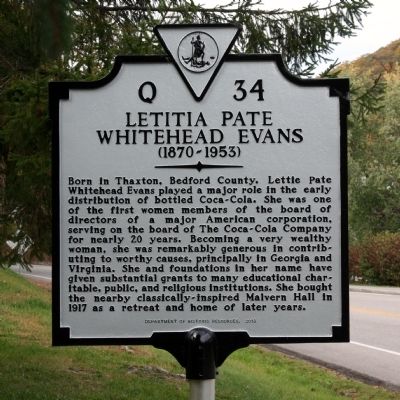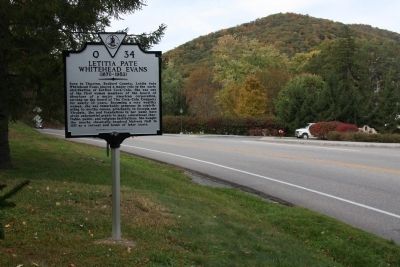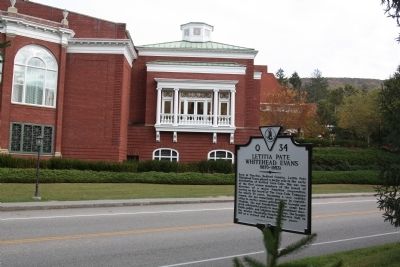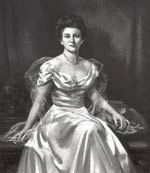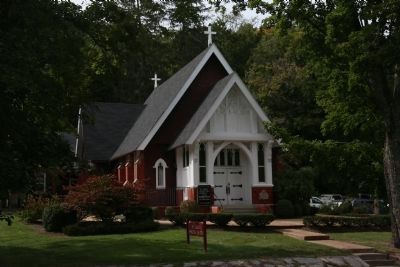Hot Springs in Bath County, Virginia — The American South (Mid-Atlantic)
Letitia Pate Whitehead Evans
(1870–1953)
Born In Thaxton, Bedford County, Lettie Pate Whitehead Evans played a major role in the early distribution of bottled Coca-Cola. She was one of the first women members of the board of directors of a major American corporation, serving on the board of The Coca-Cola Company for nearly 20 years. Becoming a very wealthy woman, she was remarkably generous in contributing to worthy causes, principally in Georgia and Virginia. She and foundations in her name have given substantial grants to many educational charitable, public, and religious institutions. She bought the nearby classically-inspired Malvern Hall in 1917 as a retreat and home of later years.
Erected 2013 by Department of Historic Resources. (Marker Number Q-34.)
Topics and series. This historical marker is listed in these topic lists: Architecture • Charity & Public Work • Industry & Commerce • Women. In addition, it is included in the Virginia Department of Historic Resources (DHR) series list. A significant historical year for this entry is 1917.
Location. 37° 59.8′ N, 79° 49.901′ W. Marker is in Hot Springs, Virginia, in Bath County. Marker is on Sam Snead Highway (U.S. 220) south of Main Street (County Route 615), on the left when traveling north. It is across the road from The Homestead Resort Hotel. Touch for map. Marker is in this post office area: Hot Springs VA 24445, United States of America. Touch for directions.
Other nearby markers. At least 8 other markers are within 5 miles of this marker, measured as the crow flies. Virginia Hot Springs Company World War Memorial (approx. one mile away); Union Hurst School (approx. 1.1 miles away); Garth Newel (approx. 2.6 miles away); Bacova (approx. 4 miles away); Warm Springs (approx. 4.1 miles away); Confederate Memorial (approx. 4.1 miles away); The County Seat of Bath (approx. 4.1 miles away); In Memory of Our Fallen Comrades (approx. 4.1 miles away). Touch for a list and map of all markers in Hot Springs.
More about this marker. The marker is adjacent to St. Luke’s Episcopal Church, where Mrs. Evans attended and where her funeral was held.
Also see . . .
1. Lettie Pate Whitehead Evans (1872-1953). The New Georgia Encyclopedia website entry:
With photograph. “[Joseph] Whitehead promoted the idea of bottling [Coca-Cola] for sales across the country, and he traveled extensively to set up bottlers and transportation throughout his extensive regions. In 1906, at the age of forty-one, he died of pneumonia, leaving behind his young widow and their eleven- and eight-year-old sons. Thus at age thirty-four Lettie Pate Whitehead, already well entrenched in Atlanta as a community leader, took over her husband's share of the massive bottling business, as well as his real estate interests. ” (Submitted on November 3, 2013.)
2. Malvern Hall. 2013 National Register of Historic Places Nomination form prepared by Bill Frazier, Beth Scripps, and Laura Purvis.
Excerpt:
- Letitia (Lettie) Pate Whitehead Evans purchased Barton Lodge in October of 1927. Mrs. Evans, born in 1870, was a native of Bedford County, Virginia. She was the widow of Joseph P. Whitehead, Sr., who with his partners, Benjamin Thomas and John Thomas Lupton, convinced Asa Candler, founder of The Coca-Cola Company, to grant them a contract for the right to bottle Coca-Cola in 1899, thus establishing the Coca-Cola Bottling Company. Mr. Whitehead then
worked to set up arrangements with local bottlers throughout the South and by 1905 had independent bottlers under contract. In 1906, while on vacation in Virginia, he died of pneumonia at the age of forty-two.
Without a will, his estate was split between his two young sons (ages 9 and 6) and his wife. Lettie’s assets were placed in the Whitehead Holding Company, the board of which she chaired. Through the holding company (also known as a parent bottler), the growing number of bottlers throughout the United States were united, relations with The Coca-Cola Company streamlined, and the classic bottle design adopted. Much of this was accomplished under the leadership of Charles Veazey Rainwater, who took over day-to-day management of the company. Mrs. Evans also became President of the Whitehead Realty Company, a family-owned company, which conducted transactions and held real estate in the Atlanta business district.
In 1913, Mrs. Whitehead married Colonel (ret.) Arthur Kelly Evans, of Toronto, Canada, a civil engineer and inventor who held an 1894 U.S. Patent for improvements to Rope-Grip, a device designed to ensure the grip on a rope. They split their time between England, Atlanta, and Hot Springs, Virginia. When she bought Barton Lodge in1927, she transferred her former residence, Pink Cottage, to her son. Mrs. Whitehead had purchased Pink Cottage in 1918 from Decatur Axtell, the original owner of the house and an early president of the Virginia Hot Springs Company. Pink Cottage is located at the intersection of Delafield Road with Hemlock Lane in much closer proximity to the hotel than the secluded location of Barton Lodge on the side of Little Mountain overlooking the hotel. It is interesting to note that her purchase of Barton Lodge occurred before construction on the Warren and Wetmore-designed tower addition to The Homestead in 1929. This construction project was on the side of the hotel closest to Pink Cottage and only a block or two away from that house.
Her 1927 purchase of Barton Lodge, which she renamed Malvern Hall, ushered in a new era of renovations and updates to the property. Lettie Pate Whitehead Evans orchestrated
the addition of two rear wings and moved the kitchen and laundry from their original basement location to the southern wing. While the Frenchs’ servants had worked in the basement, Mrs. Evans moved her cook, William Riley, and other servants to the rear of the first floor; they were still removed from the first-floor public rooms, but were no longer relegated to basement workspaces. The third floor was reserved for servant bedrooms during the Frenchs’ residency and may have continued that function under Evans’ ownership. The first-floor ceilings were modified and plaster removed as bathrooms were renovated on the second floor. The butler, Tim Bee, and maid, Julie
Sliwa, would have used the butler’s stairs to move between floors. As the automobile era rushed in, chauffeur John Mitchell would bring Mrs. Evans’s limousine to the main entrance of Malvern Hall.
In 1920, the parent bottlers had fought off an attempt by The Coca-Cola Company to cancel their original contract. By the mid-1930s, however, both the Whitehead family and original partner John Lupton agreed to that company’s purchase of the bottling rights in exchange for common stock in The Coca-Cola Company. When, in 1934, Lettie Pate Whitehead Evans became a director of The Coca-Cola Company she was one of the first women on the board of a major American corporation. She would continue on that board until her death in 1953.
After the sale of the bottling company, and continuing the example set by her first husband, Mrs. Evans was able to concentrate more on her already generous philanthropic efforts, both in Georgia and in her native Virginia. In Georgia she supported a number of colleges and healthcare facilities. Among the Virginia institutions she supported were the College of William and Mary, Washington and Lee University, Episcopal Theological Seminary, Episcopal High School, Hot Springs Valley Nursing Association, Protestant Episcopal Church Home, Boys Home in Covington, Old Customshouse in Yorktown, and Bruton Parish Church in Williamsburg. She also served as a trustee of the Virginia Museum of Fine Arts in Richmond, Virginia.
Having outlived both of her sons, in 1945 she established the Lettie Pate Evans Foundation to which the majority of her estate would be transferred, ensuring the continuation of her philanthropic efforts. The foundation’s grant program is focused on private secondary and higher education, arts and culture, and museums and historic preservation. Grants awarded in 2012 totaled over ten million dollars, including a small grant to St. Luke’s Episcopal Church in Hot Springs to aid in the restoration of two stained glass windows and renovation of their organ. Subsequent to her death in 1953, her Foundation made a gift of the Malvern Hall property in 1961 to St. Luke’s Episcopal Church
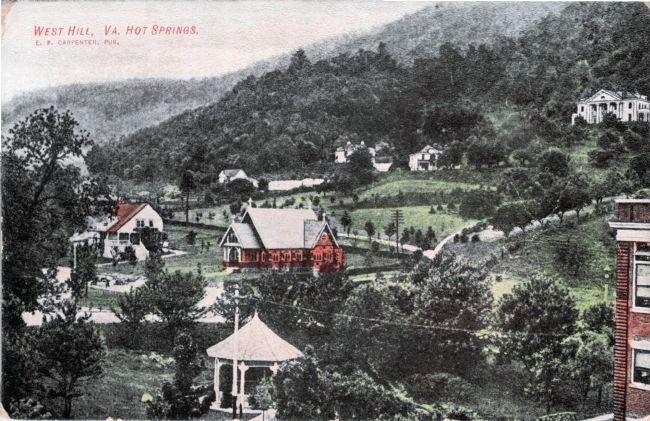
J.J. Prats Postcard Collection, 1907/1915
6. West Hill, Va. Hot Springs
Undated unmailed divided back colored postcard marked “E. F. Carpenter, publisher.” Barton Lodge, on French’s Hill on the side of Little Mountain, is in the upper right. Mrs. Evans purchased it in 1927 and renamed it Malvern Hall. St. Luke’s Episcopal Church, where Mrs. Evans attended, is in the center.
Additional commentary.
1. The Remarkable Life and Career of Letitia Pate Whitehead Evans
Remarks presented by A. J. Pate at the dedication of the Letitia Pate Whitehead Evans historical marker in Hot Springs, Virginia, September 18, 2013.
Letitia Pate was born in the small community of Thaxton, Virginia, to Cornelius Pate and Elizabeth Stagg. She was apparently known as Lettie to her family and friends, and then throughout her life. In the 1870 federal census, her father was a farmer, and she was listed as only four months old, born in February of that year.
The following decade was apparently a prosperous one for Cornelius Pate, because the 1880 census showed him as a dry goods merchant. It has been stated that Lettie attended private schools in Bedford and Lynchburg.
In 1894, she married an attorney, Joseph Brown Whitehead, and they made their home in Chattanooga, Tennessee, where their two sons were born. Her husband and an associate developed the concept of bottling Coca-Cola, which at that time was being sold as a soda fountain drink. They approached Asa Candler, founder

J.J. Prats Postcard Collection, circa 1915
7. The Homestead from Sunset Hill, Hot Springs, Virginia.
“C.T. American Art” white-border era panoramic postcard postmarked 1916 (two cent stamp), mailed folded with the picture inside. “Published by E.F. Carpenter, Hot Springs, Va.. Made in USA” A classic postcard message written on back in a neat fine-nib fountain-pen script: “Wish you were here with us. You would certainly enjoy it — very gay. Many young people. Wonderful weather. Harry arrives this morning. Hope you all are well — E.H.T.”
The Coca-Cola Bottling Company was chartered in November 1899. The first bottling plant was soon built in Chattanooga, and another in Atlanta followed shortly with the Whiteheads moving there in 1903.
The question naturally arises: Exactly what was the role of Lettie in the exponential growth of bottling Coca-Cola? I believe this question can be resolved by an objective and logical consideration of these facts:
- When her husband died in 1906 at only age 42, the bottling company was in its infancy, barely six years old, with about 80 plants in operation. Within two decades, there were more than 1000 plants.
- By 1928, bottle revenues were exceeding fountain revenues.
On her husband’s death, she immediately assumed control of the bottling company as its chairman and did not delegate her responsibilities. She soon proved herself to be an astute and savvy businesswoman, leading the rapid expansion of the business.
In 1920, The Coca-Cola Company attempted to cancel the original bottling contract, which was unsuccessful. The Woodruff family acquired the Coca-Cola Company, and Robert Woodruff became president in 1923. In the 1930s, Coca-Cola purchased the bottling rights in exchange for its common stock. Lettie thus became a major stockholder of Coca-Cola and was appointed to its board of directors in 1934, becoming one of the first women to be a director of a major American company.
Robert Woodruff became a mentor, close friend, and advisor to Lettie. She served on the board until her death in 1953 at age 83. She had survived both husbands and both of her sons. Her residual estate was given to her foundation.
In 1913, Lettie had married Arthur Kelly Evans of Canada. The Atlanta Constitution, in a front-page article about the marriage (top center, above the fold), displayed a large drawing of Lettie. The article stated that she was reputed to be the wealthiest woman in the South. The wedding, intended to be held in New York City a week earlier, was conducted in the hospital room in Lynchburg where Evans was recovering from appendicitis.
There is no indication that Evans had any involvement in the management of the bottling company. In 1927, the couple purchased Malvern Hall in Hot Springs, where they were said to have entertained such famous guests as the Vanderbilts and the Duke and Duchess of Windsor.
Today, the two foundations based on her wealth currently have over $3 billion in assets. Her philanthropies, in life and after death, are well-known, as noted on the marker and by other speakers here today. But I will cite one example where her generosity has had a major impact. Over the years, Lettie and her foundation have contributed over $340 million to Georgia Tech, making her the largest donor in its history. In recognition, they have named their historical Administration Building after her, the oldest and best-known landmark on the campus, which is also the only structure on the campus named after a woman.
Lettie was truly an extraordinary woman. Her business skills in generating wealth were equaled only by her generosity in giving it away.
On her death, the Coca-Cola board of directors wrote this memorial: “Endowed with material things, she had a conviction that she held them as trustee for the poor, the meek and the unfortunate.”
This is a worthy tribute to this great lady.
— Submitted August 8, 2014.
Additional keywords. Lettie Pate Evans
Credits. This page was last revised on March 13, 2022. It was originally submitted on November 3, 2013, by J. J. Prats of Powell, Ohio. This page has been viewed 1,753 times since then and 107 times this year. It was the Marker of the Week August 10, 2014. Photos: 1, 2, 3, 4. submitted on November 3, 2013, by J. J. Prats of Powell, Ohio. 5. submitted on September 23, 2014, by J. J. Prats of Powell, Ohio. 6. submitted on October 2, 2014, by J. J. Prats of Powell, Ohio. 7. submitted on October 27, 2014, by J. J. Prats of Powell, Ohio.
Editor’s want-list for this marker. Photo of Pink Cottage • Can you help?
